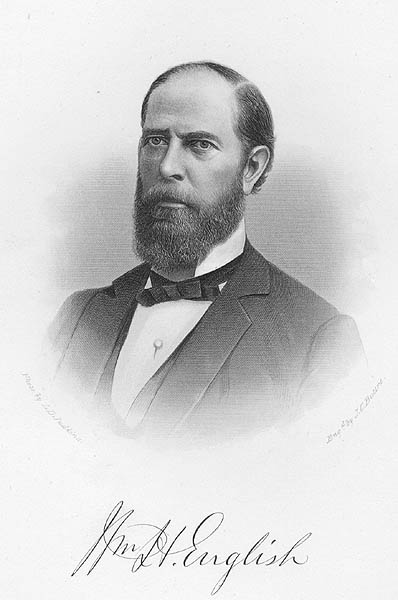|
WILLIAM H. ENGLISH
Artist: L. D. judkins _________________ Engraver: J. C. Buttre |

IMAGE IS MUCH SHARPER AND CLEARER THAN SCAN SHOWS !!
A HIGH QUALITY STEEL ENGRAVING BOOKPLATE FROM THE 1880'S!!
PERFECT FOR FRAMING AS AN ART PRINT FOR YOUR DEN !!
VERY ANTIQUE & OLD WORLD LOOKING. ITEM(s) OVER 115 YEARS OLD!!

WILLIAM H. ENGLISH was born in Lexington, Scott County, Indiana, August 27, 1822. His father, Major Elisha G. English, one of the pioneers of Indiana, when it was almost a wilderness, was a native of Kentucky, as was his mother, formerly Mahala Eastin, a descendant of Lieutenant Philip Eastin, who served in the Fourth Virginia Regiment during the war of the Revolution. Mr. English's early education was such as could be acquired in the common schools of the neighborhood in which he lived. This was supplemented by three years spent at the University of South Hanover. After finishing his course at college he studied law wherever an opportunity was presented, and before he readied the age of nineteen years was admitted to practice in the Circuit Court of his native State. When in his twenty-third year lie was admitted to practice in the Supreme Court of the United States. Though known in Indiana as a remarkably successful lawyer, he devoted the greater part of his time, when at home, to agricultural pursuits. He was for some time associated in practice with Joseph G. Marshall. Shortly after obtaining his majority Mr. English received his first official appointment, that of Postmaster of Lexington. Previous to that he had served as a delegate to the Democratic State Convention for nominating a Governor. In 1843, while only twenty-one years old, he was elected principal clerk of the Indiana House of Representatives. He entered into the political campaign of the following year with enthusiasm, and, after Polk's accession to the Presidency, he was appointed by him a clerk in the Treasury Department at Washington. He remained there four years, resigning his office upon Taylor's inauguration. In 1850 he was clerk of the Claims Committee of the United States Senate, and Secretary of the Convention which met at Indianapolis to revise the Constitution of the State of Indiana formed in In 1851 Mr. English was chosen a member of the State Legislature, and officiated as Speaker. In 1852 he was elected a Representative from Indiana to the Congress of the United States, and took his seat as a supporter of Franklin Pierce. He was a member of the House Committee on Territories, and as such participated in the debate on the Kansas-Nebraska Bill. He was re-elected in 1854, and continued to support the political measures of Mr. Pierce during the thirty-fourth Congress. He was made a Regent of the Smithsonian Institution. In 1856 he was elected to Congress for a third term, during which the controversy respecting the admission of Kansas under the Lecompton Constitution took place, which he opposed until that constitution had been ratified by the people. He officiated at the same time as chairman of the Committee on Post Offices and Post Roads. In 1858 he was elected to Congress for the fourth time, retiring in 1860, just as the secession movement was assuming an alarming aspect. This was his last political office. While holding his seat in his fourth Congressional term he opposed secession, and throughout the ensuing Civil War remained loyal to the Union. Mr. English established the First National Bank of Indianapolis, which went into business in 1863 under the National Banking Law. It was the first National bank to put its issue in circulation. He was its president for fourteen years, and was most successful in business. He resigned the presidency in 1877 on account of his health. Mr. English is above the average height, with an erect, well-made figure. His head is of good size, with regular features, the forehead is high and broad. The Democratic Convention which met at Cincinnati in June, 1880, nominated William H. English their candidate for the Vice-Presidency of the United States, and Winfield Scott Hancock of Pennsylvania for the Presidency.

SIZE: Image size in inches is 4" x 4", overall page size is 6 1/2 " x 9 1/2".
CONDITION: Condition is good. Light age toning. Nothing on reverse.
SHIPPING: Buyers to pay shipping/handling, domestic orders receives priority mail, international orders receive regular mail.
We pack properly to protect your item!
An engraving is an intaglio process of printing, with the design to be produced is cut below the surface of the plate (made of copper, steel or wood), and the incised lines are filled with ink that is then transferred to paper. The portraits on our currency are good examples of engraved images. A Photogravure is an intaglio process in which the plate is produced photographically. Please note: the terms used in our auctions for engraving, heliogravure, lithograph, line drawing, photogravure etc. are ALL images on paper.
THIS IS AN ACTUAL STEEL ENGRAVING FROM THE 1870's!
NOT A REPRODUCTION!
|
